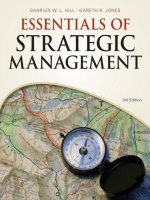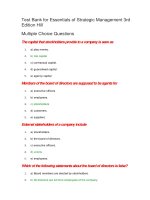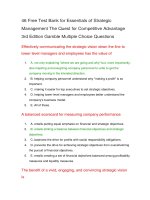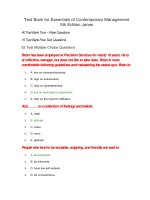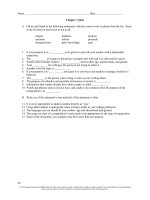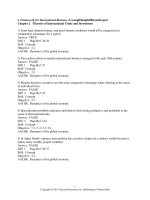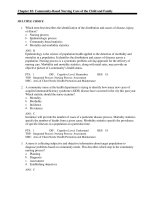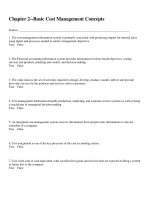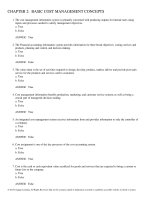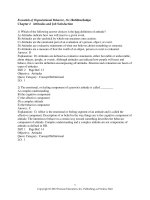Essentials of strategic management 1st edition pitt test bank
Bạn đang xem bản rút gọn của tài liệu. Xem và tải ngay bản đầy đủ của tài liệu tại đây (411.32 KB, 11 trang )
Essentials of Strategic Management
© Pitt & Koufopoulos 2011
Case study teaching notes to accompany
“Essentials of Strategic Management”
Chapter Two Case Teaching Notes: Lowe and Shawyer Ltd.
Industry context and learning focus
Long term trends in a horticultural sector trending to global operations and the impact of macro
environmental changes on enterprise survival sustainability.
Major themes that can be addressed in lectures or class discussions
The Scanstep© framework
The uncertainty-generating impact of major macro environmental forces on enterprises over long
time periods, including:
o
Long-run economic and other factors (e.g. progressive increases in personal wealth; climate
differences) on country comparative (dis)advantages
o
Evolving transport infrastructure and technology
o
Evolving social norms and preferences
The uncertainty-generating impact of major macro environmental forces on enterprises over short
time periods, including:
o
Wars
o
Short-run economic and other factors (e.g. recession; governmental priorities on industrial
policy)
o
Competition from beyond the sector (e.g. labour markets)
o
Rapid evolution of the retailing industry (supermarkets) in the 1950s
Planning for managerial succession.
Suggestions for prior preparation by students
Systematic application of the ScanStep© framework to the context of Lowe and Shawyer at various
stages of its history with particular focus on the periods after 1945.
Strategic issues particular to the enterprise(s) and context described
The table below summarises some key features of the macro environment as experienced by Lowe and
Shawyer during its lifetime. Some key macro issues are:
Social acceptance of flowers to decorate the home created a commercial market (A)
Regulations encourage the formation of a limited company (B)
Extensions to the rail transport network pioneered by the Victorians transforms access to markets
across the entire UK in late 1800s and early 1900s (C)
1914-18 and 1939-45 wars radically changes all the Scanstep© environmental factors, notably it
alters Lowe and Shawyer’s output at a stroke (D1 and D2)
Essentials of Strategic Management
© Pitt & Koufopoulos 2011
Teaching notes to accompany
“Essentials of Strategic Management”
Lowe and Shawyer applies new knowledge to the breeding of plants and adapts the physical
environment for growing flowers using heated glasshouses, significantly enhancing variety, yield
and the volume of total output (E)
Less formal and more progressive, consumer-oriented UK society after about 1950 (F)
In response, competitors begin importing plants and flowers grown in warmer climates, often using
much lower cost labour (G)
Application of new mass-production technologies (e.g. in the car industry) attracts workers to major
industrial centres, drives up wage rates and makes labour harder to attract in traditional industries
(H)
Government economic policies prioritise the development of key industries, notably reconstruction
and healthcare. Other sectors are prioritised only if they generate substantial exports (e.g. car
industry) (I).
Brief notes on the questions posed at the end of the case
1.
Outline the changes in the business environment (that is, the context in which the business worked)
that contributed to its decline.
The preceding bullet-points identify many key issues for this company. Changes can be presented
systematically within a number of time periods as per the chart below, in which the more significant
themes are highlighted in red type.
Periods in Lowe and Shawyer’s history
©
ScanStep issue
Social
Cultural
Authority (legal
and regulatory)
Natural
environment
Security
1864-1913
Stratified and
largely stable
(A)
1914-1918
Turbulent
1919-1938
Stratified but
more
dynamic
1946Rise of
consumerism
as society is
still stratified
but
increasingly
progressive (F)
Rigid patterns
Patriotic
AngloPatriotic, but
Accelerating
in Victorian and
centric but
with less
diversity, from
Edwardian
increasing
convergence
awareness of
outlook
diversity
in outlooks
other countries
and rising
immigration
Regimented;
Authoritative
Strict, but
Authoritative Citizens’ rights
strict laws (B)
more often
considered
challenged
more directly
Generally exploited with little thought to the long term consequences for the
environment or people working in it
Ineffective
Threat to the
Perceived
Severe threat
Cold war
attacks on the
British Empire
threat from
to the British military threats
established
and way of life communism
Empire and
from the Soviet
class structure
and later
way of life
bloc; economic
from fascism
threats from
transnational
competition
2
1939-1945
Turbulent
Essentials of Strategic Management
© Pitt & Koufopoulos 2011
Technological
Teaching notes to accompany
“Essentials of Strategic Management”
Increasing
mechanisation,
but industry still
labour intensive
(C)
Wars
accelerate
technological
developments
in many forms
and industry
sectors
Application
of new
technology in
many
industry
sectors (E)
Economic
Slow, but
progressively
rising wealth
War effort
redirects all
economic
activity (D1)
Financial
hardship;
perceived
threat of
global free
trade
Political
Stable, Empire
oriented
War and its
consequences
Defensive of
Britain’s
prewar status
in the world
2.
Wars
accelerate
technological
development
s in many
forms and
industry
sectors
War effort
redirects all
economic
activity (D2)
War and its
consequences
(G)
Application of
new mass
production
technologies
allied to
skilled, wellpaid workers
(H)
Post war
rebuilding
focuses
investment on
key priorities
e.g. housing
and health (I)
Reluctant
redefinition of
Britain’s status
in the world
On the basis of your answer to question 1, suggest some actions the company might have taken to
help it survive.
Actions that Lowe and Shawyer might have taken include:
Lobbying the Government to impose import duties and/or other restrictions on imported flowers and
plants
Contracting to import flowers from cheaper sources abroad
Developing consumer brand awareness for its products as premium quality, supported by enhanced
packaging
Diversifying into other horticultural or vegetable products,
Pioneering the use of covered, environmentally controlled growing environments (as did the Dutch)
for a wider range of plants or crops
Factual update on subsequent developments
Described in the case. When George Shawyer died in 1943 it seems that there was no clearly defined line
of managerial succession, which may explain why the company subsequently declined and disappeared.
3
Essentials of Strategic Management
© Pitt & Koufopoulos 2011
Teaching notes to accompany
“Essentials of Strategic Management”
Chapter Two Case Teaching Notes: The macro environment of Airbus Industrie
and the A380
Industry context and learning focus
Impact of global, medium and long-term macro environmental trends on a capital-intensive industry
(aircraft manufacture).
Major themes that can be addressed in lectures or class discussions
Why there is need for systematic analysis of current and possible future macro trends; exploring
complexity, hostility and dynamism
Environmental scanning methods and mechanisms
Coping with uncertainty and ambiguity in trend assessment/evaluation
Specific environmental trends affecting the prospects for Airbus A380
Assessing the impact of potential competition and its macro environmental determinants (n.b. this
example is discussed further in chapter 3).
Risk management
Suggestions for prior preparation by students
Investigate the role of governments in supporting the aviation industry. Address questions posed in the
case study
Strategic issues particular to the enterprise(s) and context described
Specific issues and uncertainties arise in each domain of the Scanstep © framework
Distinction between analysis of an issue and its judgemental evaluation
Lengthy timescales over which macro environmental judgements are required
Issues that impact multiple domains of the Scanstep© framework requiring appropriate reframing of
issue definitions
Brief notes on the questions posed at the end of the case
1.
Using the above study and additional recent, relevant data sources, use the ScanStep © worksheet to
analyse the macro environment that Airbus faces, with particular reference to issues that may affect
the A380.
The first table below summarises key issues that Airbus needs to be aware of and adopt considered
postures towards.
4
Essentials of Strategic Management
© Pitt & Koufopoulos 2011
Teaching notes to accompany
“Essentials of Strategic Management”
Scanstep© macro environmental issue summary for Airbus
Issue
domain
Social
Event or trend
Increasing leisure
time encourages air
cost-conscious travel
to holiday
destinations. 1
Active
stakeholder(s)
Consumers
Potential significance
Should sustain demand for new, larger
aircraft combining comfort with low cost.
An opportunity for Airbus. 2
1
Vacation travellers (including older and retired people) are being encouraged to fly further afield to
attractive new destinations. Increasing numbers of expatriates and settlers wish to visit their families in
far-off countries on a regular basis. The available UK Govt. forecast was that UK air passenger traffic was
expected to rise from 189m in 2002 to 500m by 2030 (source:
/>
2
All else equal – i.e. assuming that external constraints on flying and escalating costs do not significantly
inhibit market development.
Cultural
3
Increasing scope for
cultural exchange
visits by EU students
and other groups 3
European
Commission
Students and special
interest groups
Increasing transnational air travel is notably
by very cost-conscious people. An
opportunity for Airbus particularly if they
have the budget airlines as clients
An explicit priority of the European Commission. Also Europe to the US and to the Far East
Authority
Planning constraints
on airport expansion
are becoming tighter 4
International
regulation of civil
aviation
Airport operators
e.g. BAA
Local residents
A complex mix of
regulatory, safety
and security
agencies in host
countries6
Airport operators may be barred from
extending runways and expanding facilities
that will be vital for aircraft like the A380 to
land. A possible threat to Airbus sales. 5
Extreme complexity of negotiations for
change affecting the interests of many
governments generally makes constructive
change slow and difficult to agree.
Uncertainty may cause airlines to delay new
purchases or stick to what they are familiar
with
4
Owing to a combination of international governmental commitments as well as pressure groups with
ecological and local concerns forcing government regulators to respond.
5
New runways and longer ones will be needed at many airports (e.g. at London Heathrow) to cater for the
A380. Better passenger-handling facilities are also needed. However, larger aircraft means fewer noise
and pollution-creating flights, all else equal.
6
e.g. nationally: US FAA, UK CAA, and transnationally: EASA European Aviation Safety Authority,
IATA, WTO
Natural
environment
(ecological)
Air travel generates
large volumes of
greenhouse gases,
noise and possible
damage to the ozone
layer
Environment
pressure groups;
Government
agencies responsible
for industry
5
Probable tightening of controls on airline
routes, take-off and landing slots. Rising
demand for cleaner aircraft using less fuel
per passenger-mile. This should be an
opportunity to increase sales of the Airbus
A380 (but see note 5 above).
Essentials of Strategic Management
© Pitt & Koufopoulos 2011
Teaching notes to accompany
“Essentials of Strategic Management”
regulation
Security
Threat of terrorist
attacks
Terrorist groups.
Regulatory and
security agencies
Various challenges arise for the A380:
More complex aircraft designs. 7
Increased scrutiny of passengers and
slower boarding. 8
Airline bankruptcies. 9
7
Changes to existing aircraft have already been made e.g. bullet-proof, locked access doors to the pilots’
cabin. Future designs will be required to have greater survivability in the event of explosion damage etc.
8
Slower boarding will discourage the use of larger capacity aircraft such as the A380.
9
Causing defaults on orders and payments. Two effects might cause bankruptcy (i) targeting of particular
airlines for physical attack e.g. Islamic terrorist attack on Israel’s El Al (ii) major disruption to the
computer booking systems used by all airlines, causing chaos and loss of revenue.
Technology
Major developments
in use of composite
materials in aircraft
production
New scanning
technologies to speed
passenger and
baggage screening
Economic
Chemical
companies
Airframe
contractors
IT and security
industries
Bigger, lighter, more fuel-efficient aircraft,
but rising development costs, which present
potential threats and opportunities for
Airbus
Makes super-jumbo aircraft more viable by
speeding up flight boarding
Globalization of
business operations
Business
corporations
Growing international air travel by business
travellers, some of whom who prioritize
service and comfort, others low cost and
convenience. Implications for Airbus are
ambiguous. 10
Economic constraints
on airport expansion
Airport operators
Airport operators may be reluctant to invest
in costly, longer runways and better
facilities. 11 A significant threat to Airbus.
10
Because the needs of business and non-business travellers generally differ, internal layouts on new aircraft
will have to cater for their differing expectations.
11
Since these are vital for big aircraft like the A380 to land safely and turnaround efficiently and quickly.
Political
The USA is
politically unpopular
in many countries
Boeing and its
contractors; the US
Government.
Countries whose
governments
effectively control
their airlines and
aircraft makers
China & Russia in
particular
Their aircraft
makers
6
State-owned airlines generally buy from
their own state companies where possible.
Failing that, they may prefer Airbus over
Boeing if they have anti-American
sentiments.
Extremely difficult for external suppliers
such as Airbus to break into these essentially
captive markets.
Essentials of Strategic Management
© Pitt & Koufopoulos 2011
2.
Teaching notes to accompany
“Essentials of Strategic Management”
Assess which of the issues identified represent the most positive and most negative influences on
Airbus. Reflect on the impact-probability profiles of these issues.
The table below is an attempt to identify the most significant issues in an impact-probability assessment.
Impact-probability assessment of key macro environmental issues for Airbus in respect of the A380
Key issue
Expectations
of greater use
and
availability
of air travel
Cost
pressures on
airline
industry
Regulatory
constraints
on air travel
Technology
developments
Subjective impact
rating#
Probability rating
Impactprobability
score
Consumer
+ 9 (increasingly high
volume of users
predicted)
50% (economic austerity and
electronic means of keeping in
touch may limit the actual longterm rise)
+4.5
Business
+ 3 (absolute numbers
are much lower)
90% (global business travel will
continue to be seen as a necessity)
+2.7
Operating
- 6 (ongoing)
100% (fuel costs and taxes will
continually rise, but A380’s cost
benefits will remain disputed)
-6
Investment
-3 (risk of orders
delayed/postponed)
80% (new orders are often
delayed when confidence is low)
-2.4
Ecological
+4 (the benefits of
A380 are routespecific)
90% (tighter regulations are
almost certain, favouring A380’s
lower impact per passenger mile)
+3.6
Other
- 6 (will generally be
unfavourable to the
airline industry)
60% (and more likely than not to
happen)
-3.6
Aircraft
+8 (favour big aircraft
that spread costs over
more passengers)
75% (many are already under
development)
+6
Airport
+8
60% (under development but less
certain to succeed)
+4.8
-5 (constraints on free
market operations
imposed on aviation)
100% (governments have always
sought to regulate and influence
the aviation industry)
-5
Political influences on
aviation industry
#
+ is favourable to
Airbus 380, - is
unfavourable
Comments: the tables are intended to illustrate the methodology, not provide a definitive assessment.
Specific assessments can be the subject of class discussion.
The issues highlighted are those with the greatest impact-probability scores. They suggest that
technology is a key positive feature of the A380’s potential, but Airbus is not in a position directly to
7
Essentials of Strategic Management
© Pitt & Koufopoulos 2011
Teaching notes to accompany
“Essentials of Strategic Management”
affect all technological developments relevant to A380’s acceptance. The major negative factors suggest
the need to (i) persuade airlines how A380 can contribute to cost control and (ii) lobby governments of
all persuasions to look favourably on what Airbus is doing.
A common next step in the analysis is to sum the positives and negatives separately:
Positives: + 21.6
Negatives: -17
which suggests that the benefits of A380 are countered by significant drawbacks. If Airbus conducted an
analysis whose outcome was broadly similar, it shows the size of the gamble it took. Having made that
decision, it needs to continue to act so as to eliminate or mitigate the negative aspects.
Factual update on subsequent developments
According to Wikipedia ( as of June 2011 Airbus had 236
firm orders for the A380, of which 51 had been delivered. Six airlines were denoted as primary users, the
most committed being Emirates, which had 90 aircraft on order. However, Airbus would become
profitable only after 400+ have been delivered. The reference
may shed light on the
probability of this occurring.
8
Essentials of Strategic Management
© Pitt & Koufopoulos 2011
Teaching notes to accompany
“Essentials of Strategic Management”
Chapter Two Exercises and Questions for Further Study and Discussion
1. Do research to establish the kinds of environmental scanning and assessment companies actually
perform.
What link, if any, can you find between extent of environmental scanning and business
performance? [Note: Many academic journals, magazines and newspaper articles and company
websites etc. can help you to accumulate evidence. For example: Baron (2006); Elenkov (1997);
Garg, Walters and Priem (2003); Grant (2003); Kefalas and Schoderbeck (1973); Kourteli (2005);
Lenz and Engledow (1985); Xu, Kaye and Duan (2003)].
To this list might be added:
Dess, G.G., Lumpkin, G.T. and Taylor, M.L. (2005) Strategic Management (Ed. 2., chapter 2)
Kiesler, S. and Sproull, L.S. (1982). ‘Managerial response to changing environments: perspectives
on problem sensing from social cognition’, Administrative Science Quarterly, (vol. 27, pp. 548570)
Lutz, W. (1997), ‘Long-Term Macro Models of Population, Development, and Environment’,
Research in Human Capital and Development (Vol. 11/A, pp 249-278)
O'Connell, J.J. & Zimmermann, J.W. (1979) ‘Scanning the international environment’, California
Management Review, (vol. 22/2, pp. 15-23)
There is something of a paradox that although an understanding of the macro and micro
environments has arguably never been more important, in terms of numbers of research articles
published, it seemingly receives less academic attention than in the past. Of course, scanning activity
is costly and does not guarantee success at isolating critical variables and events in advance.
Demonstrating a definitive empirical link between scanning and performance is difficult because it is
virtually impossible to isolate the scanning variable(s) from the many other variables that can bear
on performance. Research often uses executive opinion about scanning and takes a broad definition
of performance. Davis (2008) for example presents a recent doctoral study: ‘Does environmental
scanning by systems integration firms improve their business development performance?’ (See:
/>Most enterprises limit external scanning to their industry sector(s) including key competitors,
government and other regulatory developments likely to bear on their activities, including
membership of sector representative bodies for the purpose of to lobbying. Entry to new sectors and
overseas markets typically results in commissioning of external research projects to address specific
issues of concern.
2. Focus on emerging macro environmental trends in the ScanStep © fields that most interest you.
Assess their possible implications for the following types of enterprises:
a.
An international manufacturing corporation
b.
A retail banking group
9
Essentials of Strategic Management
© Pitt & Koufopoulos 2011
c.
Teaching notes to accompany
“Essentials of Strategic Management”
A university that relies on overseas students for a high proportion of its income.
Trends noted could include:
a.
Competitive cost pressures from low cost, emerging countries; new technologies; less time to
exploit new products before they are superseded
b.
Uncertain economic conditions; threat of default on governmental debt; adverse public opinion;
c.
Greater competition from institutions in other countries; difficulty of recruiting enough high
calibre staff; changing societal expectations about the value of higher education.
3. Reflect on the assumptions you made in the previous exercise: how can their validity be tested
practically?
In principle, identifying assumptions provides an opportunity to test them in advance and may help
future understanding of why the world did not develop as expected. Some assumptions can be tested
via appropriate, empirical research (qualitative or quantitative), the use of game theory and other
kinds of analysis. The challenge, however, is to brief researchers with the ‘right’ questions. Other
assumptions over environmental issues are really no more than untestable ‘hunches’ propounded by
senior executives whose authority results in short-circuiting of more objective assessment (chapter
6). Nonetheless, especially in small adaptive enterprises, these judgements may actually be
preferable to the risk if expending too much time and money on research that ultimately produces
unreliable findings.
4. Reflect critically on the following statement: ‘progressive, innovative enterprises do not react or
respond to trends, they establish them. So environmental scanning is of limited strategic value to
such enterprises.’
It is true that innovative enterprises such as Apple Computer and Dyson work hard to create new
products that consumers did not know they needed or would find attractive. Thus they create markets
and new industry sectors in which competitors are disadvantaged and reactive. Do such enterprises
do no scanning? Almost certainly they do, but they generally focus on the variables that are
perceived as relevant to their circumstances and open to objective measurement and forecasting e.g.
GDP per capita (disposable income); availability of support infrastructures (e.g. electronics firms
target clienteles having access to good electricity, internet and telephone networks). The evidence is
that large corporations (defence contractors are a recent example) get wrong-footed by events they
did not anticipate or (more likely) knew of, but could do little to affect (e.g. government cuts on
defence equipment expenditure). Progressive enterprises must, of course, take care to innovate at a
pace their clienteles can accept and afford, yet retain adequate sensitivity and flexibility to adapt to
the unforeseen.
5. Examine other accounts of the successes of scenario analysis. [Note: In addition to the references
cited already, see: Burt et al. (2006); chapter 14 of McGee, Thomas and Wilson (2005); Mercer
10
Essentials of Strategic Management
© Pitt & Koufopoulos 2011
Teaching notes to accompany
“Essentials of Strategic Management”
(1998); Schoemaker (1995); Walsh (2005).]Are you persuaded or has hindsight been invoked in
support of the claims made for this technique?
The key point about scenario analysis is not that a scenario is a forecast with calculable probability
of occurring, but a vision (a gestalt) of what cannot be ruled out as a plausible future, however
unlikely it may currently seem. Once envisioned its implications can be explored as well as the
paths that could lead towards it. This kind of analysis may prove vital for understanding and
realising desirable global futures such as the ‘hydrogen economy.’ It seems highly probable that all
major vehicle and energy companies as well as academic and governmental agencies are examining
this scenario and its particular implications for them. Naturally, it is always easier in the popular
literature to discuss successful (realised) scenarios after the event than failed (non-realised) ones. So
there is a temptation to ‘talk up’ the positive cases, not least if one is a scenario consultant ….
11
